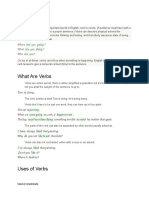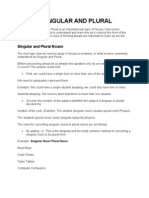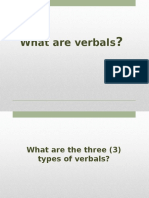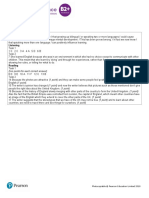0 ratings0% found this document useful (0 votes)
88 viewsAdjectives GFHG: So What Is The Correct Order of Adjectives Before A Noun?
Adjectives GFHG: So What Is The Correct Order of Adjectives Before A Noun?
Uploaded by
vanessa rodriguez minayaThe correct order of adjectives before a noun is usually: Opinion – Size – Age – Shape – Color – Origin – Material – Purpose. This order is known by the acronym OSASCOMP. While the order is not always fixed, it is preferred to follow this structure when describing nouns with multiple adjectives. The types of adjectives include opinion, size, age, shape, color, origin, material, and purpose. Examples are given to illustrate the typical ordering of different adjective types before nouns.
Copyright:
© All Rights Reserved
Available Formats
Download as DOCX, PDF, TXT or read online from Scribd
Adjectives GFHG: So What Is The Correct Order of Adjectives Before A Noun?
Adjectives GFHG: So What Is The Correct Order of Adjectives Before A Noun?
Uploaded by
vanessa rodriguez minaya0 ratings0% found this document useful (0 votes)
88 views3 pagesThe correct order of adjectives before a noun is usually: Opinion – Size – Age – Shape – Color – Origin – Material – Purpose. This order is known by the acronym OSASCOMP. While the order is not always fixed, it is preferred to follow this structure when describing nouns with multiple adjectives. The types of adjectives include opinion, size, age, shape, color, origin, material, and purpose. Examples are given to illustrate the typical ordering of different adjective types before nouns.
Original Title
ADJECTIVES.docx
Copyright
© © All Rights Reserved
Available Formats
DOCX, PDF, TXT or read online from Scribd
Share this document
Did you find this document useful?
Is this content inappropriate?
The correct order of adjectives before a noun is usually: Opinion – Size – Age – Shape – Color – Origin – Material – Purpose. This order is known by the acronym OSASCOMP. While the order is not always fixed, it is preferred to follow this structure when describing nouns with multiple adjectives. The types of adjectives include opinion, size, age, shape, color, origin, material, and purpose. Examples are given to illustrate the typical ordering of different adjective types before nouns.
Copyright:
© All Rights Reserved
Available Formats
Download as DOCX, PDF, TXT or read online from Scribd
Download as docx, pdf, or txt
0 ratings0% found this document useful (0 votes)
88 views3 pagesAdjectives GFHG: So What Is The Correct Order of Adjectives Before A Noun?
Adjectives GFHG: So What Is The Correct Order of Adjectives Before A Noun?
Uploaded by
vanessa rodriguez minayaThe correct order of adjectives before a noun is usually: Opinion – Size – Age – Shape – Color – Origin – Material – Purpose. This order is known by the acronym OSASCOMP. While the order is not always fixed, it is preferred to follow this structure when describing nouns with multiple adjectives. The types of adjectives include opinion, size, age, shape, color, origin, material, and purpose. Examples are given to illustrate the typical ordering of different adjective types before nouns.
Copyright:
© All Rights Reserved
Available Formats
Download as DOCX, PDF, TXT or read online from Scribd
Download as docx, pdf, or txt
You are on page 1of 3
At a glance
Powered by AI
The typical order of adjectives before a noun is Opinion-Size-Age-Shape-Color-Origin-Material-Purpose, as represented by the mnemonic OSASCOMP. However, this order is not always fixed and some variations are possible.
The main categories of adjectives are Opinion, Size, Age, Shape, Color, Origin, Material, and Purpose.
The mnemonic to remember the typical order of adjectives before a noun is OSASCOMP, which is formed from the first letter of each category: Opinion-Size-Age-Shape-Color-Origin-Material-Purpose.
ADJECTIVES So what is the correct order of
adjectives before a noun?
gfhg The order of adjectives before a noun is usually
the following:
Word Order Opinion – Size – Age – Shape – Color – Origin –
Material – Purpose
If we take the first letter of each one, it
creates OSASCOMP which is an easy way to
remember the order.
Let’s look at an example about describing a bag.
It is an ugly small old thin red Italian
cotton sleeping bag
It is not common to have so many adjectives
before a noun, but I do this so you can see the
correct order of adjectives.
Ugly is an opinion, small is a size, old refers to
age, thin refers to shape, red is a
color, Italian refers to its origin, cotton refers to
the material the bag is made of, sleeping is the
purpose of the bag.
I will go into more details about each of these
categories in a moment. First, let’s see two more
examples:
A beautiful long white French silk wedding
dress.
What is an adjective?
Large ancient Greek clay flower vases.
An adjective is a word that describes something
Let’s study the first one.
(a noun).
Here we have a dress. Dress is a noun, the name
An adjective gives us more information about a
of a thing. Let’s describe this dress.
person or thing.
What type of dress is it? What is the purpose of
this dress?
Correct order of adjectives It is used for weddings so it is…
Adjectives sometimes appear after the verb To a wedding dress.
Be (CARD – LINK TO VIDEO) Let’s image the dress is made of silk. It isn’t made
The order is To Be + Adjective. of plastic or gold, it is made of silk.
He is tall. Silk is a material so it goes before the purpose.
We say it is:
She is happy.
Adjectives sometimes appear before a noun. a silk wedding dress.
The order is Adjective + Noun. Now, this dress was made in France. France is a
noun, its adjective is French.
Slow car
Its origin is French. Its origin, French, goes before
Brown hat the material, Silk. So we say it is:
BUT… Sometimes you want to use more than one
a French silk wedding dress.
adjective to describe something (or someone).
Let’s add the color of the dress. What color is it?
What happens if a hat is both brown AND old?
White. Color goes before Origin so we say it is:
Do we say… an old brown hat OR a brown old hat?
An old brown hat is correct because a certain a white French silk wedding dress.
order for adjectives is expected. What is the shape of this dress? Is it long or
A brown old hat sounds incorrect or not natural. short? It is long. The adjective Long goes under
the category of shape because shape also covers
weight or length. (We will see more about this in a
moment) We now say it is:
SIZE
Size: Adjectives about size tell us how big or small
a long white French silk wedding dress. something is.
Let’s add one more adjective. Is the dress Some examples of adjectives referring to size are:
beautiful or ugly? Well, you should always say it is
big, small, tall, huge, tiny, large, enormous
beautiful or it will ruin her wedding day.
For example: a big fat red monster.
Beautiful is an opinion and adjectives about
Notice how big is first because it refers to size
opinions go before all the other adjectives. So our
and fat is next because it refers to shape or
final description of the dress is:
weight. Then finally we have the color red before
a beautiful long white French silk the noun.
wedding dress.
Now of course we don’t normally add so many AGE
adjectives before a noun. This example is just to
Age: Adjectives of age tell us how old someone or
show you the order of adjectives.
something is. How old is it?
Some examples of adjectives referring to age are:
The order is NOT fixed old, young, new, antique, ancient
IMPORTANT: The order of adjectives before a For example: a scary old house
noun is NOT 100% FIXED. Scary is my opinion, old refers to the age of the
This chart is only a guide and is the order that is house. Scary is before old because opinion is
preferred. before age.
You may see or hear slight variations of the order
of adjectives in real life though what appears in
the chart is the order that is expected the most. SHAPE
Now, let’s look at each type of adjective in more Shape / Weight / LengthThese adjectives tell us
detail (with examples)… about the shape of something or how long or
short it is. It can also refer to the weight of
someone or something.
Types of Adjectives Some examples of adjectives referring to shape
are:
round, square, long, fat, heavy, oval,
OPINION
Opinion: These adjectives explain what we think skinny, straight
about something. This is our opinion, attitude or For example: a small round table.
observations that we make. Some people may What is the shape of the table? It is round.
not agree with you because their opinion may be What is the size of the table? It is small.
different. These adjectives almost always come The order is small round table because size is
before all other adjectives. before shape.
Some examples of adjectives referring to opinion
are: COLOR
delicious, lovely, nice, cool, pretty, Color: The color or approximate color of
comfortable, difficult something.
For example: She is sitting in Some examples of adjectives referring to color
a comfortable green armchair. are:
Comfortable is my opinion or observation, the green, blue, reddish, purple, pink, orange,
armchair looks comfortable. The armchair is red, black, white
also green. (adding ISH at the end makes the color an
Here we have two adjectives. The order approximate color, in this case reddish is
is comfortable green armchair because Opinion “approximately red”)
(comfortable) is before Color (green). Our example: a long yellow dress.
What is the color of the dress? It is yellow.
The dress is also long. Long which is an adjective
of shape or more precisely length, is before an opinion. Some people think my desk is messy. So,
adjective of color. the order is opinion before purpose.
ORIGIN
Origin: Tells us where something is from or was
created.
So this is the general order of adjectives in
Some examples of adjectives referring to origin
English and you can remember them by the
are:
mnemonic OSASCOMP.
American, British, Indian, Turkish, Chilean, BUT did you know that we could add some extra
Australian, Brazilian categories?
Remember, nationalities and places of origin start
with a capital letter. BONUS ADJECTIVE GROUPS
For example: an ancient Egyptian boy.
We can add the adjective categories
His origin is Egyptian. Egyptian needs to be with a
of Number and Condition.
capital E which is the big E.
Ancient refers to age so it goes before the
adjective of origin. NUMBER
Number: Tells us the amount or quantity of
something.
MATERIAL It is not only for normal cardinal numbers like,
Material: What is the thing made of or what is it
one, two, three… but also other words that refer
constructed of?
to quantity such as many or several.
Some examples of adjectives referring to material
Our examples of adjectives referring to numbers
are:
are:
gold, wooden, plastic, synthetic, silk,
One, two, three, many, several
paper, cotton, silver For example: three hungry dogs
For example: a beautiful pearl necklace Number adjectives go before all the other
Pearl is a material. They generally come from adjectives, including adjectives about opinion.
oysters. Hungry is a condition or state so the order is
The necklace is made of what material? It is made Three hungry dogs.
of pearls.
The necklace is also beautiful so I put this
adjective of opinion before the adjective referring
CONDITION
Condition: Tells us the general condition or state
to material.
of something
Our examples of adjectives referring to condition
PURPOSE or state are:
Purpose/Qualifier/Use:What is it used for? What
Clean, wet, rich, hungry, broken, cold, hot,
is the purpose or use of this thing? Many of these
adjectives end in dirty
–ING but not always. For example: Two smelly old shoes.
Some examples of adjectives referring to purpose Smelly is a condition or state. Smelly is
are: before old which refers to age. The
number two is at the beginning as numbers
gardening (as in gardening gloves),
always are.
shopping (as in shopping bag), riding (as in riding
boots)
Our example: a messy computer desk
What is the purpose of the desk? It is a place for
my computer, it is designed specifically to use
with a computer. It is a computer desk. In this
case, the desk is also very messy. Messy is an
You might also like
- Word Form Exercise For TOEICDocument6 pagesWord Form Exercise For TOEICNgọc Vũ NguyễnNo ratings yet
- Reduced Forms AEDocument2 pagesReduced Forms AEelizabetaaNo ratings yet
- New England Colonies Lesson PlanDocument4 pagesNew England Colonies Lesson PlanRajkovi1No ratings yet
- WC Punctuating With ApostrophesDocument2 pagesWC Punctuating With ApostrophesMian Hussain AhmadNo ratings yet
- Modal Verbs: 1. CAN Use Examples Speak English. I Go To The Cinema?Document6 pagesModal Verbs: 1. CAN Use Examples Speak English. I Go To The Cinema?saraNo ratings yet
- Coursera Teaching With Technology ReadingsDocument14 pagesCoursera Teaching With Technology ReadingsRosmery RiberaNo ratings yet
- PrepositionsDocument19 pagesPrepositionsNasir MalikNo ratings yet
- Ountable Nouns: A Dog Is An AnimalDocument9 pagesOuntable Nouns: A Dog Is An AnimalJoseMa AralNo ratings yet
- Forming Nouns and Adjectives Derived From VerbsDocument6 pagesForming Nouns and Adjectives Derived From VerbsBeri DarioNo ratings yet
- ACTION VERBS Are Words That Indicate ActionDocument10 pagesACTION VERBS Are Words That Indicate ActionCristianto SudinoNo ratings yet
- The Simple Present TenseDocument23 pagesThe Simple Present TenseohsiambnoNo ratings yet
- Countable Vs Uncountable Nouns+articlesDocument11 pagesCountable Vs Uncountable Nouns+articlesAntonio JaimesNo ratings yet
- 1definite and Indefinite Articles PDFDocument5 pages1definite and Indefinite Articles PDFgnomonicoNo ratings yet
- Relative Pronouns: Relative Pronoun Use ExampleDocument3 pagesRelative Pronouns: Relative Pronoun Use ExampleAnonymous yyzxrD3No ratings yet
- 8+9. The Article With Countable+Uncountable NounsDocument12 pages8+9. The Article With Countable+Uncountable NounsD1chuNo ratings yet
- Reciprocal Pronoun: Reciprocal (Adj.) : Given orDocument9 pagesReciprocal Pronoun: Reciprocal (Adj.) : Given orAnisnabila Reezal100% (1)
- Gerunds: Gerund As SubjectDocument4 pagesGerunds: Gerund As SubjectbumfromjerseyNo ratings yet
- Rhyme: Example: Brat, Fat, Mat, SatDocument33 pagesRhyme: Example: Brat, Fat, Mat, SatGuy Minecraft100% (1)
- Top Links For Intermediate LevelDocument12 pagesTop Links For Intermediate LevelwuacbekirNo ratings yet
- NEW Total English: Elementary LevelDocument15 pagesNEW Total English: Elementary LevelEduardo Israel Sanchez Ayala100% (1)
- English VocabularyDocument4 pagesEnglish VocabularyIrvin John Diao CapistranoNo ratings yet
- Linking VerbsDocument5 pagesLinking VerbsEzekiel D. Rodriguez100% (4)
- VerbsDocument21 pagesVerbsDarah Faye MacatangayNo ratings yet
- Sentences With Prepositions of Place and DirectionDocument5 pagesSentences With Prepositions of Place and Directionmialge2001100% (1)
- Sentence Patterns SV, Sva EtcDocument17 pagesSentence Patterns SV, Sva EtcSili Wong0% (1)
- Partner Share: Describe A Movie Where A Toy Comes To LifeDocument21 pagesPartner Share: Describe A Movie Where A Toy Comes To Lifekashifbutty2kNo ratings yet
- Regular Verbs ListDocument7 pagesRegular Verbs ListYolandaNo ratings yet
- Esl Topics Quiz AdjectivesadverbsDocument3 pagesEsl Topics Quiz AdjectivesadverbsGabriela TohatNo ratings yet
- Homonym PacketDocument23 pagesHomonym PacketFranz MascardoNo ratings yet
- Parts of Speech TableDocument27 pagesParts of Speech TableGugunInterNo ratings yet
- SaidDocument2 pagesSaidapi-259636773No ratings yet
- Verbs: Base Form - Ing Form Past Tense Past ParticipleDocument53 pagesVerbs: Base Form - Ing Form Past Tense Past ParticipleEva.lineNo ratings yet
- NounsDocument5 pagesNounsMohd ZulfadliNo ratings yet
- How To Write A Good ParagraphDocument15 pagesHow To Write A Good ParagraphLala FridaNo ratings yet
- Simple Form Simple Past Past Participle: Irregular Verbs: A Reference ListDocument2 pagesSimple Form Simple Past Past Participle: Irregular Verbs: A Reference ListDenir Roberto de OliveiraNo ratings yet
- Ao5 Unit 9 QuantifiersDocument15 pagesAo5 Unit 9 Quantifiersapi-240618645No ratings yet
- Bare - Uncovered Basis - A Basic Principle: Bases - Four Stations On A Baseball FieldDocument3 pagesBare - Uncovered Basis - A Basic Principle: Bases - Four Stations On A Baseball FieldSUBHADIP GANGULINo ratings yet
- Lets Practice How To Write A Paragraph 2 PDFDocument2 pagesLets Practice How To Write A Paragraph 2 PDFLaura Victoria Franco MoraNo ratings yet
- Problem and SolutionDocument9 pagesProblem and Solutionapi-500138048No ratings yet
- English Adverb PresentationDocument29 pagesEnglish Adverb Presentationjames danicaNo ratings yet
- InfinitivesDocument12 pagesInfinitivesdinejedidahNo ratings yet
- HE Ollective OUN: Recognize A Collective Noun When You See OneDocument6 pagesHE Ollective OUN: Recognize A Collective Noun When You See OneDorina DanilaNo ratings yet
- Grammar 101Document14 pagesGrammar 101Reza Ayah MaharaniNo ratings yet
- Student. Short - CLEFT SENTENCESDocument5 pagesStudent. Short - CLEFT SENTENCESDumitrița PopaNo ratings yet
- Synonyms Are Words of The Same Grammatical Class (Nouns, Verbs, Adjectives, Etc.) ThatDocument9 pagesSynonyms Are Words of The Same Grammatical Class (Nouns, Verbs, Adjectives, Etc.) Thatsanyasirao1No ratings yet
- Examples of English TensesDocument17 pagesExamples of English TensesKeerthi VasanNo ratings yet
- Prefix and SuffixDocument14 pagesPrefix and Suffixmirza100% (2)
- Voiced and Voiceless ConsonantsDocument4 pagesVoiced and Voiceless ConsonantsMelissa Baun BesamNo ratings yet
- Collocations: Part in SomethingDocument1 pageCollocations: Part in SomethingSandra Del Pozo RamaNo ratings yet
- Phrase PrepositionalDocument2 pagesPhrase PrepositionalGuillermo OrtizNo ratings yet
- Gerunds and InfinitivesDocument15 pagesGerunds and InfinitivesMaria Jose SanzNo ratings yet
- Word Order 1Document30 pagesWord Order 1AgungNo ratings yet
- Gerund and InfinitiveDocument33 pagesGerund and InfinitiveꂅᏒꂅภ ᕱᏒᏕᎥภ100% (1)
- Grade 10: Idiomatic Expressions: Roles in The FamilyDocument4 pagesGrade 10: Idiomatic Expressions: Roles in The FamilySamuel Urdaneta SansoneNo ratings yet
- English GrammarDocument52 pagesEnglish Grammarcassori75% (4)
- Adjectives - Grammar: Opinion Size AGE Shape Colou R Origin MaterialDocument3 pagesAdjectives - Grammar: Opinion Size AGE Shape Colou R Origin MaterialDéboraFernandesNo ratings yet
- Verb To Be For KidsDocument2 pagesVerb To Be For KidsZankuro100% (1)
- Keys To Family ResilienceDocument13 pagesKeys To Family ResilienceP.Ch.O.No ratings yet
- Comparing and Contrasting Grammar PDFDocument26 pagesComparing and Contrasting Grammar PDFsurendo100% (1)
- Plural Nouns Verbs in Third Person Possessive CaseDocument2 pagesPlural Nouns Verbs in Third Person Possessive Casevanessa rodriguez minayaNo ratings yet
- Nouns: List of Nouns - Concrete Noun ExamplesDocument9 pagesNouns: List of Nouns - Concrete Noun Examplesvanessa rodriguez minayaNo ratings yet
- Countable and Uncountable NounsDocument4 pagesCountable and Uncountable Nounsvanessa rodriguez minayaNo ratings yet
- Collective Nouns: Common Group NamesDocument8 pagesCollective Nouns: Common Group Namesvanessa rodriguez minaya100% (1)
- S + Adjective: Apostrophe S - Meanings and UsesDocument6 pagesS + Adjective: Apostrophe S - Meanings and Usesvanessa rodriguez minaya100% (2)
- Adverbs of Frequency: The Position of The Adverb in A SentenceDocument2 pagesAdverbs of Frequency: The Position of The Adverb in A Sentencevanessa rodriguez minayaNo ratings yet
- Adverbs and AdjectivesDocument6 pagesAdverbs and Adjectivesvanessa rodriguez minayaNo ratings yet
- Cooking Words With Pictures and Examples: BarbecueDocument3 pagesCooking Words With Pictures and Examples: Barbecuevanessa rodriguez minaya100% (1)
- Parts of A HouseDocument9 pagesParts of A Housevanessa rodriguez minayaNo ratings yet
- List of VerbsDocument3 pagesList of Verbsvanessa rodriguez minayaNo ratings yet
- CEFR Year 3 - Unit 1 - I CanDocument9 pagesCEFR Year 3 - Unit 1 - I CanWAN YEE XIAO MoeNo ratings yet
- Do's and Don'ts of Academic WritingDocument2 pagesDo's and Don'ts of Academic WritingHaydee Kristine A. Luzon - LabastillaNo ratings yet
- English Language Curriculum12Document23 pagesEnglish Language Curriculum12EltNo ratings yet
- Assignment No2 CC (20 CS 101& 20 CS 69)Document24 pagesAssignment No2 CC (20 CS 101& 20 CS 69)Aleeza AnjumNo ratings yet
- Grammar: PronunciationDocument11 pagesGrammar: PronunciationaniNo ratings yet
- The Branches of LinguisticsDocument6 pagesThe Branches of Linguisticsyeseniacampos0314No ratings yet
- Tutor: - Roberta Noélia Távora de Carvalho - Aluno: - Thaiana Barros Dos SantosDocument3 pagesTutor: - Roberta Noélia Távora de Carvalho - Aluno: - Thaiana Barros Dos SantosTHAIANA BARROS DOS SANTOS UFCNo ratings yet
- SHARE Strategy Implementation Report 2A 7 StepsDocument12 pagesSHARE Strategy Implementation Report 2A 7 StepsNikos Stathopoulos100% (1)
- UNIT 3: Answer Key: Skills Test ADocument2 pagesUNIT 3: Answer Key: Skills Test ABelen GarciaNo ratings yet
- LPPMS Orientation and DiscussionDocument20 pagesLPPMS Orientation and DiscussionZay CaratihanNo ratings yet
- English Task FirstDocument11 pagesEnglish Task FirstNayeli TipanNo ratings yet
- Traductor 1 BilingueDocument43 pagesTraductor 1 BilingueVANESSA AVILA ALANISNo ratings yet
- q1 - l2 - Slang and ColloquialismDocument23 pagesq1 - l2 - Slang and ColloquialismBrazilNo ratings yet
- 03 - UB02002 SOW (Students)Document4 pages03 - UB02002 SOW (Students)Windyee TanNo ratings yet
- Inside Ah B 31d-31eDocument2 pagesInside Ah B 31d-31eluizafftavares70No ratings yet
- Speech Act (Interrogative, Question, Exclamative Imperative and Directive, Minor Clause)Document24 pagesSpeech Act (Interrogative, Question, Exclamative Imperative and Directive, Minor Clause)Fatasya KarimNo ratings yet
- Nigeria Spelling Bee 17 18 Study GuideDocument26 pagesNigeria Spelling Bee 17 18 Study GuideImam-Malik Abdullahi KagaNo ratings yet
- Grade 9 - Writer's EffectDocument33 pagesGrade 9 - Writer's EffectPrapti PatelNo ratings yet
- RPH PKP M33 3108Document18 pagesRPH PKP M33 3108Nor FarehaNo ratings yet
- GorlachDocument18 pagesGorlachBongani MahlanguNo ratings yet
- Natural Languages VsDocument4 pagesNatural Languages VsSwornim MaharjanNo ratings yet
- 1&2 - Review and Check - AnswersDocument1 page1&2 - Review and Check - AnswersAmandaNo ratings yet
- W12.Rhythm LinkingDocument19 pagesW12.Rhythm LinkingThu Phương Dương ThịNo ratings yet
- Poetry Recital Rubric - Reading 4Document1 pagePoetry Recital Rubric - Reading 4Blaise Longos GaccionNo ratings yet
- 1-Insert The Right Phrasal Verb.: Look Out Look Up Look After Take Off Take Up Look DownDocument3 pages1-Insert The Right Phrasal Verb.: Look Out Look Up Look After Take Off Take Up Look DowntabitNo ratings yet
- Date SheetDocument1 pageDate Sheetnayyabkanwal2004No ratings yet
- He Berlitz Self-Teacher - German - IntroDocument2 pagesHe Berlitz Self-Teacher - German - IntroInversion Digital2No ratings yet
- Final Test of English Grade 5Document2 pagesFinal Test of English Grade 5Bendrasse ManuelNo ratings yet
- Laghu Siddhanta Kaumudi - Shared Q&A Sheet - 02 - AchsandhiDocument8 pagesLaghu Siddhanta Kaumudi - Shared Q&A Sheet - 02 - AchsandhiOnkar YemulNo ratings yet



































































































